Tackle storage options for bass fishing lures have come a long way since the old fashioned folding tray tackle boxes we used to use. And with the amount of lures most bass fishermen have today it’s certainly warranted.
Keeping your tackle organized is essential if you want to be efficient on the water. Rummaging through boxes trying to find what you’re looking for does nothing but take time away from your fishing.
Plus lures today are expensive, so keeping them stored properly will keep them protected and increase their lifespan. It can even help keep the hooks and split rings from rusting, some tackle boxes more than others but we’ll get in to that.
Types of Lure Storage
There are many different ways to store bass lures, so you can really customize just how you want them organized. You can still go as simple as a classic folding tray tackle box, or as far as some of the newer-age tackle systems with multiple sub bags and boxes.
Because bass lures come in many different shapes and styles, there are better ways of storing certain lures than others. For example, the best way to store swimbaits will differ from the best way to store spinnerbaits.
The first thing you need to identify is how complex of a bass fisherman you are. If you’re a very simple fisherman you could probably get away with just one medium sized tackle box. This is how most anglers start out, then they expand from there.
But you should know what options are available before you start making buying decisions. You don’t want to buy a box and later find there was a storage option that would have been better suited for your collection. So before we get into categorizing lures, let’s take a look at the different types of tackle boxes and bags.
Utility Boxes
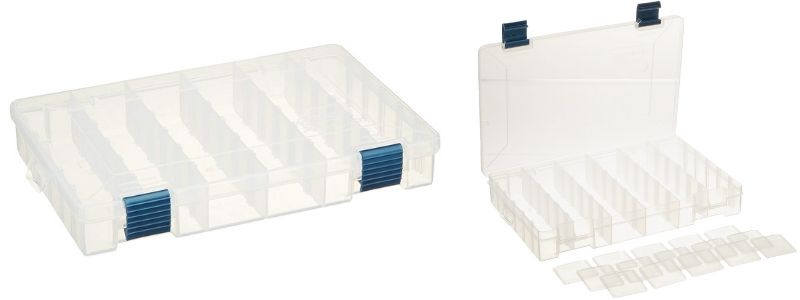
The most common way fishermen store bass lures is using some sort of utility box, or sometimes called utility trays. You may also hear anglers refer to them as “Plano Boxes”, because the company Plano is so universally known for making them.
But utility boxes are made by many different companies, and come in multiple shapes, depths, and sizes. Their internal dividers will differ, giving you some different layouts to decide between. But some of the dividers also typically removable, so you can customize the layout of the box.
The range of size options and customization flexibility these boxes offer make them an ideal choice for tailoring to your lure collection. By simply moving the dividers around you can increase or decrease the size of the lure slots.
For usually not too much of price increase you can get waterproof utility boxes, which in most cases is well worth the additional cost. Keeping your lures dry and free of moisture will prevent rust, which is a hard fought battle in lure storage.
Tackle Bags & Backpacks
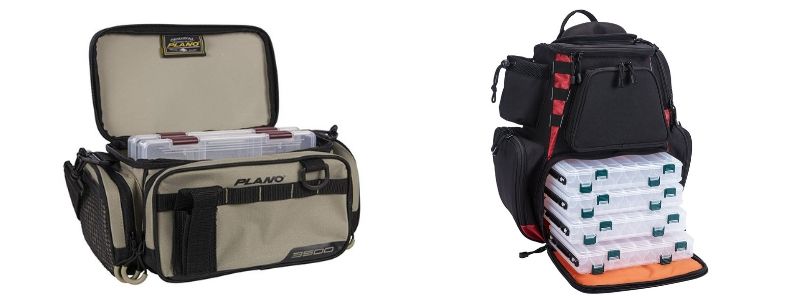
These style bags are the best way to store and carry your lures for a fishing expedition. They are easy to toss on your boat or back, and have everything you need with you for a day of fishing.
The utility boxes we talked about above are usually integrated within tackle bags and backpacks. And if they aren’t, then they are at least usually designed to be able to fit them inside.
They are usually equipped with a good amount of pockets and pouches for other tackle like pliers, scissors, line spools, your fishing license, etc. That way when you are ready to fish you have all the necessary items packed already.
Using utility boxes and tackle bags together makes it very easy to prepare your lure arsenal for a fishing trip. Once you know what you need for lures, you can simply put the utility boxes you need for that day in to the bag.
Worm Bags, Binders, & Wallets
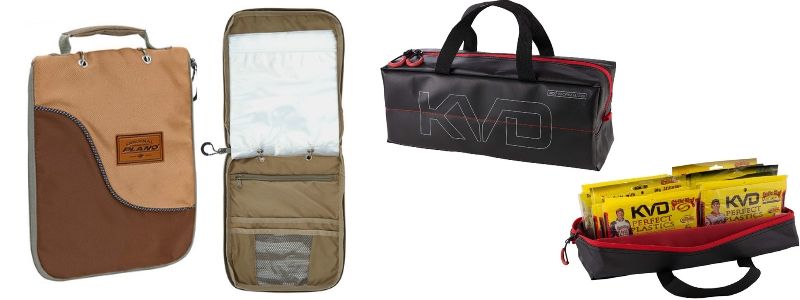
Basic worm bags are simply a canvas or plastic resealable bag that you store packages of soft plastic worms in. They come in wide range of sizes and styles so you can equip yourself with exactly what you need for storage.
Binders and wallets are pretty much the same thing, in that they provide a means for storing soft plastics. But these storage systems use multiple plastic bags within them called binder bags. They called that because they connect to rings inside the binder/wallet, similarly to the way loose leaf paper connects to a conventional binder.
They allow you to quickly browse through hundreds of worms as easily as turning the pages of a book. This also gives you the flexibility to sort them in whatever order makes sense to you.
Folding Tray Tackle Boxes
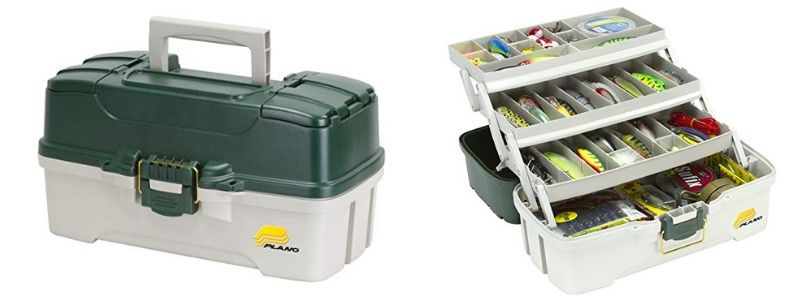
Of course we can’t talk about lure storage without mentioning classic folding tray tackle boxes. You’ll hardly see advanced bass fishermen using these, but they make a great starting point for beginners.
They come in a good range of sizes, but the most popular ones are considered mid-sized. These usually come equipped with two or three trays in them that open and expand when the box is opened. As the box closes the trays fold in and allow the cover to close over them.
These boxes are more than sufficient for storing what a beginner needs to do some casual bass fishing. They have slot storage on the trays for lures and a large open space below for bigger items like a scale, spool of line, pliers etc.
Categorizing Lures
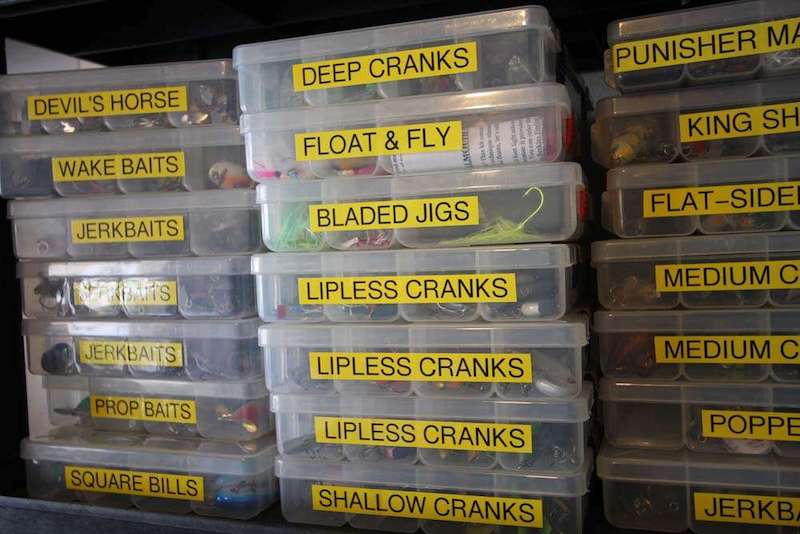
If you are serious about bass fishing then you own, or need to own, a large selection of lures. And the best way to store them is by separating them by category in to designated boxes.
For example you may have one or more designated spinnerbait boxes, and one or more designated crankbait boxes, etc. Naturally, keeping your lures organized like this is going to make it fast and easy to find what you’re looking for when you’re fishing.
But on top of that, it allows you the flexibility to only carry what you need on a given day of fishing. If you know you are not going to be fishing crankbaits that day then you don’t take the crankbait box with you. Then if you need crankbaits on your next trip you simply swap out a box you don’t need for the crankbait box.
This will reduce weight and clutter in your boat or tackle bag. Keeping it as simple as possible is the best way to increase efficiency and maintain an organized tackle system.
Hard Bait Storage
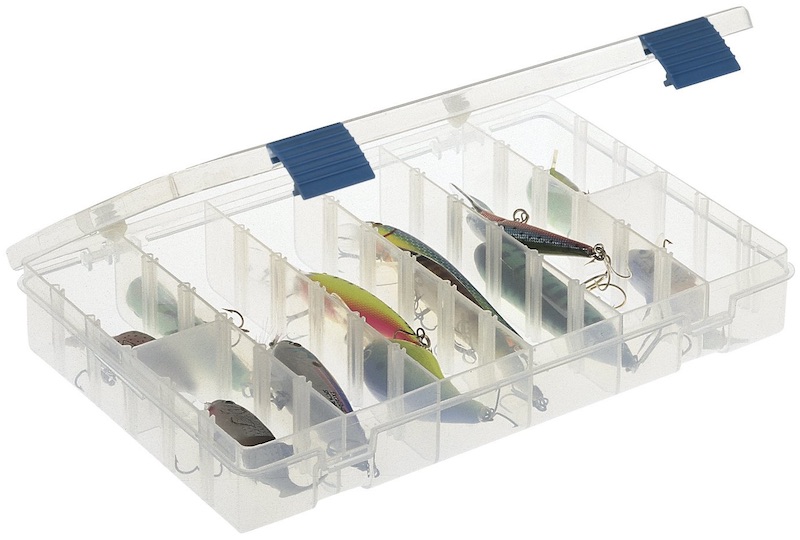
Hard baits make up the largest category of bass lures. The best way to store and organize hard baits is by using the aforementioned utility boxes. These boxes allow you to give each lure its own slot, in whatever size or order you want them to be in.
The customization flexibility you have by being able to move the dividers make these boxes perfect for tailoring your box to your hard bait collection. For example, if you’re storing shallow running crankbaits you can make the slots smaller. But if you need to store jerkbaits you can make the slots bigger for their longer profiles.
Then again you might not fish a ton of crankbaits and jerkbaits, in which case you could combine them in the same box. How you breakdown your boxes will depend on what techniques you fish. Here is an example of how you might breakdown your hard baits in to boxes.
- Crankbaits
- Jerkbaits
- Topwater
- Swimbaits
- Jigs
Most hard baits have treble hooks that will tangle up with other lures, some anglers prefer for each lure to have their own slot. This also keeps the lures from banging up against each other and risking paint chipping.
With that said, it’s not uncommon practice to store two similar lures in the same slot. If done properly it can actually help keep the baits from sliding around in the slot as a result of filling up more of the slot space. It’s also more practical to utilize as much space in the box as possible.
Ideally you want to find a brand and box size that you really like and get multiples of them. This way they stack evenly when you store them in a tackle bag or on a shelf. Although not necessary, it’s great for keeping your boxes stored nicely together.
Soft Bait Storage
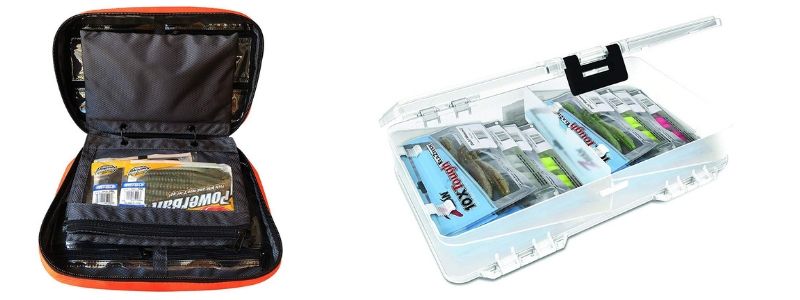
When you have the amount of soft plastics that most anglers have, keeping them organized is essential. And on top of having multiple styles of soft plastics, there are even more colors and sizes of those styles.
How you breakdown your soft plastics into subcategories lies heavily on how many soft plastic techniques you fish. For example if you fish a lot of jigs then it makes sense to have a worm bag that is designated to jig trailers. If you don’t, then tossing some jig trailers in with another worm bag is fine.
But if you fish a certain soft plastic a lot then then it makes a ton of sense to designate a bag to that technique. For example if you do a lot of finesse worm fishing, then having a finesse worm bag for your shakey heads and dropshots naturally makes sense.
It may seem like overkill but once you factor in the multiple colors, styles, and sizes you’ll likely want/need, this bag will fill up pretty quickly. Here is an example of how you might break down your soft plastics in to seperate bags and binders.
- Rubber Worms
- Finesse Worms
- Tubes & Grubs
- Jig Trailers
- Soft Swimbaits
Worm bags and binders make finding soft plastics a quick and easy process while keeping them all neatly together. You can quickly browse through hundreds of neatly stored worms with the flexibility to sort them in whatever order you want.
There are also hard tackle boxes that are designed for worm storage. Some even have clips inside the hold the bags in place. This is really just a matter of preference, you may like they way worm boxes store with your other utility boxes.
The biggest advantages with hard boxes is the protection they provide, and the availability of waterproof models. The biggest disadvantage is they typically store less bags of worms. But there’s no reason you couldn’t use both styles.
Wire Bait Storage
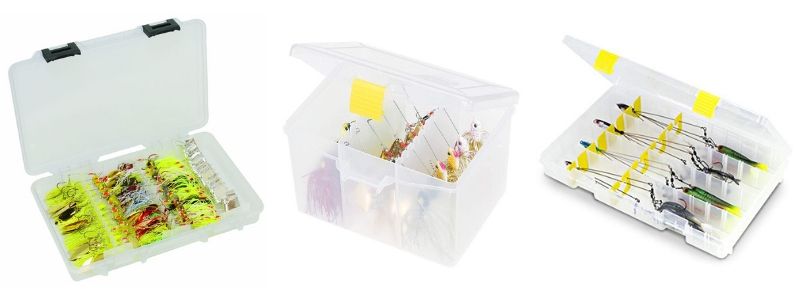
These style baits stand alone in requiring their own means of storage, well proper storage we should say. By wire baits of course we are talking about spinnerbaits, buzzbaits, and Alabama rigs.
These lures are uniquely shaped with their wireframes and are better stored in boxes specifically designed for them. This is especially true for Alabama Rigs, which store nicely in A-rig boxes, and can’t imagine storing them without one.
But for storing spinnerbaits and buzzbaits you can always get away with cutting grooves in the dividers of a standard utility box for the wire to pass through. This way the blade sits in one slot and the hook sits in the adjacent slot.
However, there are some really nice spinnerbait boxes that will keep these baits stored perfectly and in good condition. You should also consider a waterproof box, since these baits are made up of all metal components are prone to rust.
Lure Wraps
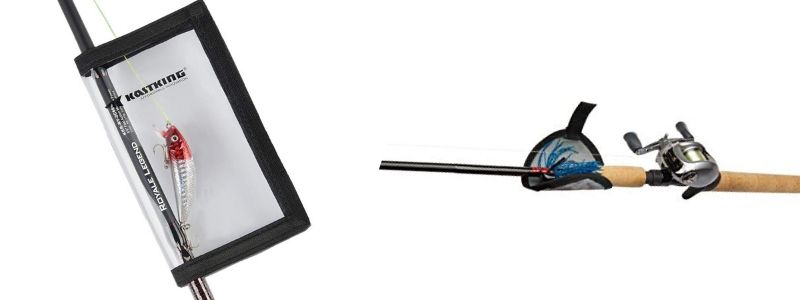
Whether your rod is on a rack or laying on the deck of your bass boat, one lure is usually always being stored tied to it. This is when some anglers like to use lure wraps to protect their lures.
Lure wraps are typically made of canvas or a flexible plastic. They wrap around your lure as well as the rod where the lure hooks to it. In most cases they fasten closed with velcro so you can adjust the tightness.
Lure wraps are especially great for lures with treble hooks. They prevent the hooks from snagging things like the carpeting on your boat, your clothes, or worse: your skin.
They also keep the lures from banging up against the rod, this is especially nice when traveling. The constant banging of a crankbait or jig head against the shank of the rod is not good for the lure nor the rod. The bullet weight of a texas rig or punch rig can really do some damage to a rod.
Quality Matters
The quality and prices of tackle boxes and bags range significantly. They can feel cheap and flimsy on the low end, or strong and sturdy on the higher end. This is actually something truly worth paying close attention to.
If you invest in a good quality tackle storage system it can last a lifetime. Cheap tackle boxes and bags are made from cheap materials, and where out and break down rather quickly. While the quality plastic and canvas on the better tackle systems will endure the wear and tear fishermen put on them.

